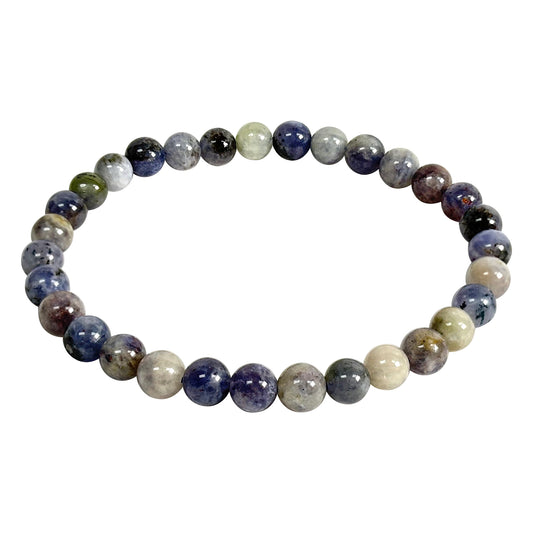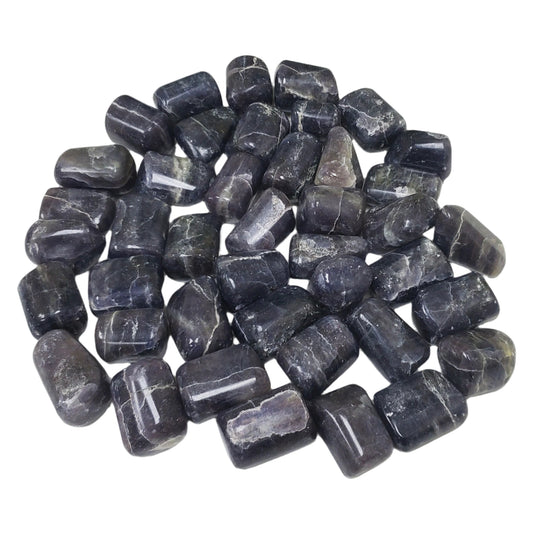Iolite Stone
-
Regular price $11.99 USDRegular priceUnit price / per
-
Regular price $49.99 USDRegular priceUnit price / per
The name Iolite is derived from the Greek word "ios" which translates to "violet." Iolite is also at times referred to as Cordierite, named after Pierre Louis Antoine Cordier, who was a French mineralogist. Iolite is often utilized as a less expensive substitute for gemstones such as Blue Sapphire even though Iolites contain more of a purple tint when compared to Blue Sapphires. Iolite is most commonly cut into both facets and cabochons which are mainly utilized in jewelry making such as pendants, bracelets, rings, necklaces, and earrings as well.

Iolite's most noticeable characteristic is known as pleochroism. Pleochroism is when a stone showcases a variety of colors that change depending on the light and angle the stone is viewed from. Iolites can appear to look either blue or violet and when rotated the color changes to either a light blue or a shade of a yellowish grey.
Iolite can be found in various areas located all over the world. These places are India, Norway, Brazil, Kenya, Tanzania, and Sri Lanka. In 1994 a large Iolite deposit was found located in Madagascar.
In metaphysical belief, Iolite is believed to sustain the spirit of exploration, journey, intuition, and dreams. Iolite is known as the "Vikings Compass"" and is said to possess the ability to provide/stimulate feelings of hope during difficult times.
Uses of Iolite Stone
-
Jewelry: Iolite’s stunning blue and violet shades make it popular in rings, pendants, earrings, and bracelets. Its durability and pleochroism add to its allure, making it an intriguing gemstone in jewelry collections.
-
Meditation and Spirituality: Iolite is commonly used in meditation to enhance intuition, support mental clarity, and promote emotional balance. It is said to activate the third-eye chakra, helping one connect to their inner wisdom.
-
Energy Healing: In crystal healing practices, iolite is believed to support emotional healing by helping one release negative energy and promote calmness.
-
Home Décor and Collectibles: Due to its rich color and historical significance, iolite is also used in decorative items like crystal grids, figurines, and as a part of gemstone collections.
Metaphysical Properties of Iolite
Iolite is known as a stone of exploration and insight. It is believed to enhance personal power and self-confidence by helping one gain a clear perspective, especially in times of change or uncertainty. Its association with the third-eye chakra makes it ideal for those seeking spiritual guidance or exploring intuitive abilities. Iolite is also thought to assist in releasing old emotional wounds and reducing feelings of stress, making it a supportive stone for meditation and self-reflection. Additionally, some believe iolite supports detoxification, both physically and emotionally.
What is the origin of iolite's name?
Iolite derives from the Greek word ios, meaning "violet," which references the stone's deep, beautiful violet-blue hue.
Is iolite suitable for daily wear in jewelry?
With a Mohs hardness of 7 to 7.5, iolite is relatively durable but should still be handled with care, especially in rings or bracelets that might experience impact.
How does iolite benefit meditation?
Iolite is thought to activate the third-eye chakra, enhancing intuition, clarity, and spiritual insight, making it beneficial for those focused on self-discovery and personal growth.
Where is iolite commonly found?
Iolite is sourced from countries such as India, Sri Lanka, Brazil, and Madagascar, each producing stones with unique color qualities.
Can iolite be used in energy healing?
Yes, iolite is popular in crystal healing practices for its believed ability to promote emotional healing, reduce stress, and help one overcome negative patterns or blockages.


